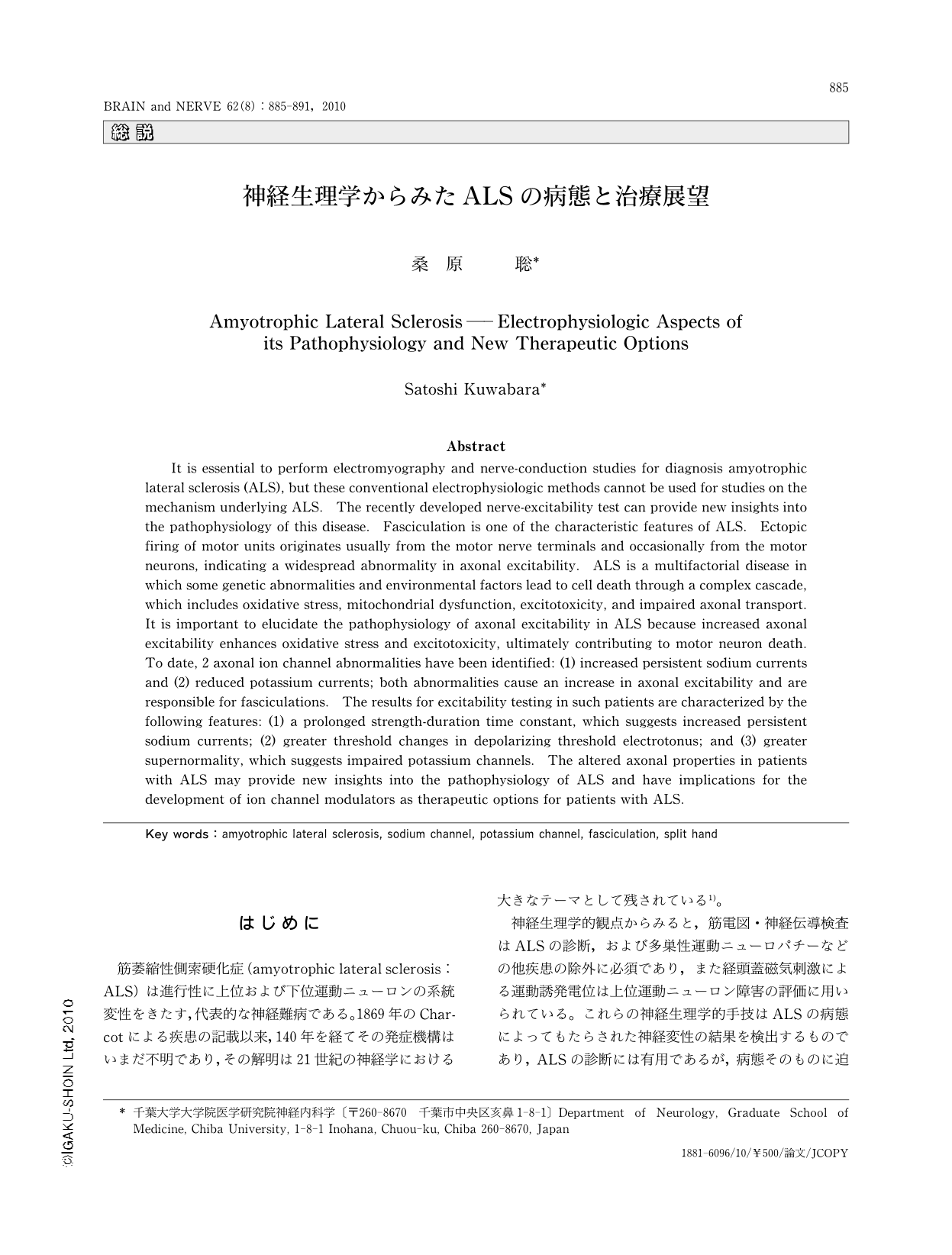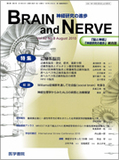Japanese
English
- 有料閲覧
- Abstract 文献概要
- 1ページ目 Look Inside
- 参考文献 Reference
はじめに
筋萎縮性側索硬化症(amyotrophic lateral sclerosis:ALS)は進行性に上位および下位運動ニューロンの系統変性をきたす,代表的な神経難病である。1869年のCharcotによる疾患の記載以来,140年を経てその発症機構はいまだ不明であり,その解明は21世紀の神経学における大きなテーマとして残されている1)。
神経生理学的観点からみると,筋電図・神経伝導検査はALSの診断,および多巣性運動ニューロパチーなどの他疾患の除外に必須であり,また経頭蓋磁気刺激による運動誘発電位は上位運動ニューロン障害の評価に用いられている。これらの神経生理学的手技はALSの病態によってもたらされた神経変性の結果を検出するものであり,ALSの診断には有用であるが,病態そのものに迫る手法としての意義は限られていた。
しかし,近年新たなアプローチとして,下位運動ニューロンの軸索特性の変化を検討することが可能となり2),また磁気刺激によって上位運動ニューロンの興奮性を評価する試みもなされ3),ALSの病態に神経生理学的側面から迫ろうとする一連の研究が進められている。これまでの検討の結果をまとめると“皮質運動ニューロン,脊髄運動ニューロン軸索の興奮性は増大している”ことに集約される。
神経細胞~軸索興奮性増大に対応するALSの臨床症候の最大の特徴は線維束性収縮(fasciculation)である。線維束性収縮は一般に下位運動ニューロン徴候とされてきたが,多くの神経原性筋萎縮性疾患の中で広範な線維束性収縮を呈するものはALSのみである。脊髄性筋萎縮症,頸椎症性筋萎縮症や軸索変性型ニューロパチーにおいて線維束性収縮は稀にしかみられない。このことは線維束性収縮が筋萎縮性疾患の中でALSにかなり特異的に生じており,運動ニューロン死に関与している可能性を示唆している。
本稿ではALSにおいて運動ニューロン死に関わるメカニズムとして推定されている細胞生物学的異常(酸化ストレス,細胞内蛋白凝集,ミトコンドリア機能異常,軸索輸送障害,グルタミン酸興奮毒性,グリア細胞機能異常1))を踏まえて,線維束性収縮を中心に神経生理学的観点からALSの病態についてこれまでに得られている知見を概説する。
Abstract
It is essential to perform electromyography and nerve-conduction studies for diagnosis amyotrophic lateral sclerosis (ALS),but these conventional electrophysiologic methods cannot be used for studies on the mechanism underlying ALS. The recently developed nerve-excitability test can provide new insights into the pathophysiology of this disease. Fasciculation is one of the characteristic features of ALS. Ectopic firing of motor units originates usually from the motor nerve terminals and occasionally from the motor neurons,indicating a widespread abnormality in axonal excitability. ALS is a multifactorial disease in which some genetic abnormalities and environmental factors lead to cell death through a complex cascade,which includes oxidative stress,mitochondrial dysfunction,excitotoxicity,and impaired axonal transport. It is important to elucidate the pathophysiology of axonal excitability in ALS because increased axonal excitability enhances oxidative stress and excitotoxicity,ultimately contributing to motor neuron death. To date,2 axonal ion channel abnormalities have been identified: (1) increased persistent sodium currents and (2) reduced potassium currents; both abnormalities cause an increase in axonal excitability and are responsible for fasciculations. The results for excitability testing in such patients are characterized by the following features: (1) a prolonged strength-duration time constant,which suggests increased persistent sodium currents; (2) greater threshold changes in depolarizing threshold electrotonus; and (3) greater supernormality,which suggests impaired potassium channels. The altered axonal properties in patients with ALS may provide new insights into the pathophysiology of ALS and have implications for the development of ion channel modulators as therapeutic options for patients with ALS.

Copyright © 2010, Igaku-Shoin Ltd. All rights reserved.


